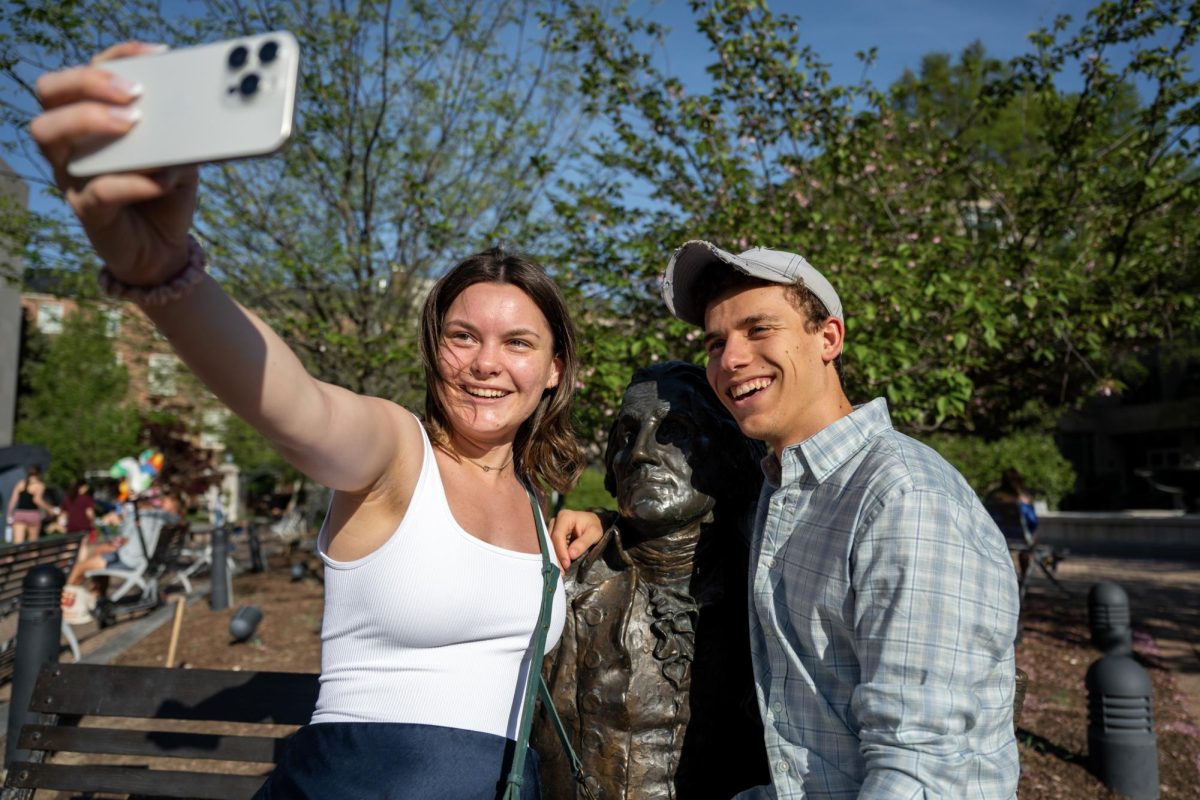For one hour on Friday afternoon, a Tompkins Hall room full of GW freshmen and sophomores was transformed into an elementary school science class.
Freshman Juliet Adams and sophomore Isabel Verghese imagined that their classmates were fifth-grade students as they taught a sample lesson plan about mixtures and solutions – using Jell-O as an example to explain the concept.
“Does everyone understand how when you are mixing the Jell-O powder and the water, you are creating a mixture?” Verghese said.
Adams and Verghese are two of 32 students in GWTeach, a new program this semester that allows any undergraduate student majoring in science, technology, engineering or math fields to become a licensed K‒12 teacher in those subjects by the time they graduate. The program is the first of its kind at GW, and is something that its directors hope will attract more STEM-minded students.
Filling a national need
STEM has been a priority for GW officials for the last several years, as they’ve pushed to raise their research profile nationally and poured millions of dollars into a high-class engineering building.
The program – part of GW’s STEM Academy – helps fill what experts say is a gaping hole in teacher training: teachers who have a specialty in the STEM fields. To begin closing the gap, President Barack Obama has announced initiatives over the last several years to pour millions of dollars into STEM programs, and the National Science and Technology Council released a five-year plan in 2013 to promote STEM education.
Sophomore Samantha Lumpkin, a physics major, joined GWTeach when a program director recruited students in one of her classes last year. There is no application for the program. Lumpkin simply signed up and enrolled in a free one-credit teaching course where she learned how to develop lessons and work with children.
“I’ve always been really interested in teaching and this was a really good way to integrate teaching into my studies and also provide a backup plan,” she said.

Lumpkin said the most “rewarding” part of the program is turning her knowledge of science into something children can learn by visiting K‒12 classrooms in D.C. five times a semester – like Beers Elementary School in Southeast and Oyster-Adams Bilingual School in Northwest. In order to teach children about animal life cycles, for example, Lumpkin cares for mealworms, which she then brings to the classes.
If Lumpkin and other GWTeach students decide they want to stick with the program after completing the first one-credit course, they must fulfill the rest of the 27 credits – which cover topics like modeling functions and classroom interactions.
Larry Medsker, the program’s associate director, said that because GW has not previously offered any undergraduate education programs, GWTeach is an alternative to pursuing a STEM minor as an undergraduate and later having to attend graduate school to become a teacher – saving time and money. GW does not have another undergraduate program for students interested in becoming teachers.
“In a lot of education programs, at other schools that have those for undergraduates, you don’t necessarily get a STEM major. You take some science courses and you major in education,” he said. “But these days, the National Science Foundation and other people are really emphasizing the need to get a deep experience in the STEM topic, like an actual physics degree, or biology or chemistry, and do the education courses along with them.”
Medsker, who is a physics professor, is running the program along with Graduate School of Education and Human Development Dean Michael Feuer and faculty in the Columbian College of Arts and Sciences and GSEHD.
GW was one of about 40 schools chosen to create the teaching program, which is modeled after the UTeach program started in 1997 at the University of Texas at Austin. GW will receive $1.45 million over the next five years to develop the program, part of a larger grant from the Howard Hughes Medical Institute to the National Math and Science Initiative.
Learning by teaching
After Adams and Verghese presented, other pairs of students took turns lecturing the class on topics like insect behaviors – sketching diagrams of earthworms on a whiteboard – and which rocks would be strong enough to build a monument.
In order to prepare for their school visits, the students work with GWTeach “master teachers,” faculty who have taught STEM subjects to K‒12 students.
At the end of each lesson, master teachers Alicia Bitler, a research instructor in curriculum and pedagogy, and Megan Hollibaugh Baker encouraged students to write down feedback for their classmates who had just presented, highlighting which parts of the lesson plan would engage actual children and which parts might be unclear.

Hollibaugh Baker said GWTeach will arm the students with the information they need to be better STEM teachers in the future.
“One thing I’ve heard from many teachers is that, especially at elementary and middle school levels, is they didn’t have that background and content knowledge,” Hollibaugh Baker said. “They feel a little more insecure in the classroom and they don’t have that confidence to bring that knowledge in.”
While some students – like Verghese, who said that teaching is her “plan C” – use GWTeach as something to fall back on once they graduate, other students, like Adams, have realized they want to pursue teaching as a career.
Adams and Verghese added that when they apply the skills they learn from GWTeach, they are encouraging other generations of students to take an interest in STEM.
“How much are you going to remember from what you learned in fifth grade?” Verghese said. “As long as you remember that you enjoyed science, then are more enthusiastic about it later, that’s going to keep more students in the STEM field.”







